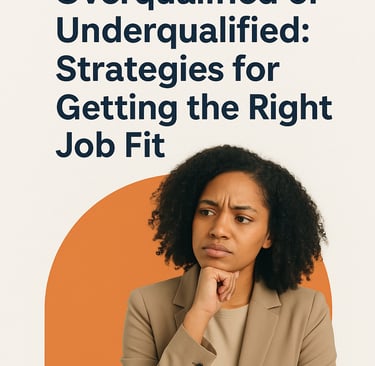Overqualified or Underqualified: Strategies for getting the right job fit
Struggling to find a role that fits your skills and career goals? Whether you’re overqualified or underqualified, landing the right job can be challenging. This article explores practical strategies to position yourself effectively, highlight your value, and secure a role that aligns with your experience, potential, and ambitions.
CAREER & SKILLS DEVELOPMENT
E-Spire
10/1/20252 min read


Landing a job that truly matches your skills and career goals can sometimes feel like threading a needle. Many professionals find themselves in situations where they are either overqualified or underqualified for the roles they are pursuing. Both scenarios can be frustrating and impact your career growth if not navigated strategically. Here’s a guide to understanding these challenges and strategies for securing the right job fit.
Understanding the Challenge
Overqualified
Being overqualified means your skills, experience, or education exceed what a role demands. While this may seem like an advantage, it can create concerns for employers:
Fear of high salary expectations
Worries about boredom or lack of engagement
Concerns that you may leave for a better opportunity soon
Underqualified
Being underqualified means you lack some of the skills, experience, or qualifications listed in a job description. This can lead to:
Hesitation from employers to hire you
Potential job stress due to skill gaps
Feeling unprepared or insecure in the role
Strategies for Overqualified Candidates
Tailor Your Application
Focus on relevant skills and experience that directly match the job. Avoid listing extensive achievements that may intimidate hiring managers.Show Commitment
Address concerns upfront in your cover letter or interview by expressing genuine interest in the role, highlighting your enthusiasm for the company culture, and emphasizing long-term commitment.Focus on Value, Not Title
Emphasize how your experience can help the team achieve goals efficiently rather than stressing your seniority.Be Open to Lateral Moves
Sometimes a lateral move or a role slightly below your experience level can provide valuable exposure and opportunities for growth in a new field or company.
Strategies for Underqualified Candidates
Highlight Transferable Skills
Identify skills from past experiences that are relevant to the role and show how you can adapt quickly. Examples include communication, problem-solving, or project management.Invest in Learning
Take online courses, attend workshops, or earn certifications to close gaps in knowledge and demonstrate commitment to growth.Be Honest, But Positive
Acknowledge skill gaps, but focus on your eagerness to learn and adapt. Employers often value attitude and potential as much as experience.Leverage Networking
Connections in your desired industry can advocate for your potential, helping employers see beyond the “missing qualifications.”
Finding the Right Fit
The key to avoiding mismatched job placements is self-awareness and research:
Assess Your Skills and Goals: Understand what you bring to the table and what you hope to achieve.
Research Companies: Look for organizations whose culture, growth opportunities, and job requirements align with your profile.
Consider Flexibility: Sometimes roles can be customized if you can clearly demonstrate value.
Conclusion
Being overqualified or underqualified doesn’t have to be a roadblock. With strategic positioning, honest communication, and a focus on transferable skills, you can navigate these challenges and secure a role that aligns with your abilities and career goals. Remember, the right job fit isn’t just about a perfect match on paper, it’s about the alignment of skills, growth potential, and job satisfaction.
